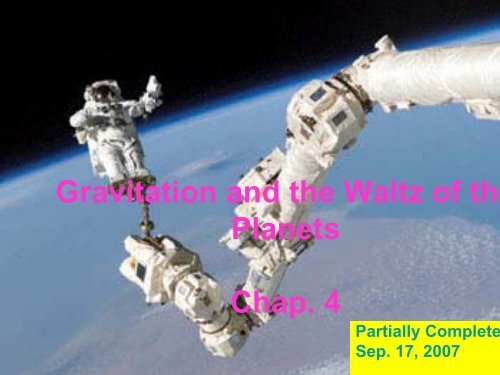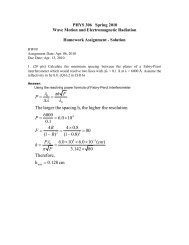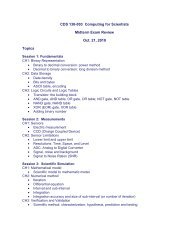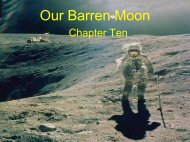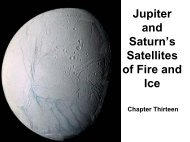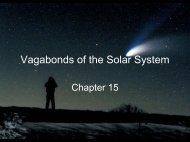Gravitation and the Waltz of the Planets Chap 4
Gravitation and the Waltz of the Planets Chap. 4
Gravitation and the Waltz of the Planets Chap. 4
Create successful ePaper yourself
Turn your PDF publications into a flip-book with our unique Google optimized e-Paper software.
<strong>Gravitation</strong> <strong>and</strong> <strong>the</strong> <strong>Waltz</strong> <strong>of</strong> <strong>the</strong><br />
<strong>Planets</strong><br />
<strong>Chap</strong>. 4<br />
Partially Complete<br />
Sep. 17, 2007
ASTR 111 – 003 Fall 2007<br />
Lecture 03 Sep. 17, 2007<br />
Introduction To Modern Astronomy I:<br />
Solar System<br />
Introducing Astronomy<br />
(chap. 1-6)<br />
<strong>Planets</strong> <strong>and</strong> Moons<br />
(chap. 7-15)<br />
<strong>Chap</strong>. 16: Our Sun<br />
<strong>Chap</strong>. 28: Search for<br />
Extraterrestrial life<br />
Ch1: Astronomy <strong>and</strong> <strong>the</strong> Universe<br />
Ch2: Knowing <strong>the</strong> Heavens<br />
Ch3: Eclipses <strong>and</strong><br />
<strong>the</strong> Motion <strong>of</strong> <strong>the</strong> Moon<br />
Ch4: <strong>Gravitation</strong> <strong>and</strong><br />
<strong>the</strong> <strong>Waltz</strong> <strong>of</strong> <strong>the</strong> <strong>Planets</strong><br />
Ch5: The Nature <strong>of</strong> Light<br />
Ch6: Optics <strong>and</strong> Telescope
Ancient Geocentric models<br />
• Ancient astronomers believed <strong>the</strong> Earth to be at <strong>the</strong> center<br />
<strong>of</strong> <strong>the</strong> universe, <strong>and</strong> <strong>the</strong> Earth is at rest<br />
• All <strong>the</strong> stars are fixed on <strong>the</strong> celestial sphere, rotating once<br />
a day<br />
• The Sun <strong>and</strong> Moon move slowly eastward with respect to<br />
<strong>the</strong> stars
Planetary Motion<br />
• Like <strong>the</strong> Sun <strong>and</strong> Moon, <strong>the</strong> planets usually move slowly<br />
eastward on <strong>the</strong> celestial sphere with respect to <strong>the</strong><br />
background <strong>of</strong> stars<br />
• This eastward progress is called direct motion<br />
• Retrograde motion: but from time to time, <strong>the</strong> planets<br />
stop, <strong>and</strong> move westward for several weeks or months<br />
The Path <strong>of</strong> Mars in 2011-2012<br />
FLASH<br />
0402b_Path<strong>of</strong>Mars.swf
Ptolemaic System: cycles on cycles<br />
• Ptolemaic system (~ 200 AD): each planet is<br />
assumed to move in a small cycle called an epicycle,<br />
whose center in turn moves in a large cycle, called a<br />
deferent, which is centered on <strong>the</strong> Earth<br />
• Both <strong>the</strong> epicycle <strong>and</strong><br />
deferent rotates in <strong>the</strong><br />
same direction ----<br />
counter clock-wise<br />
FLASH<br />
0403003.swf
Ptolemaic System: cycles on cycles<br />
• When <strong>the</strong> planet is on <strong>the</strong> part <strong>of</strong> its epicycle nearest<br />
Earth, <strong>the</strong> motion <strong>of</strong> <strong>the</strong> planet along <strong>the</strong> epicycle is<br />
opposite to <strong>the</strong> motion <strong>of</strong> <strong>the</strong> epicycle along <strong>the</strong><br />
deferent. The planet <strong>the</strong>refore appears to go backward<br />
in retrograde
Heliocentric Model by Copernicus<br />
• Heliocentric (Suncentered)<br />
model: all <strong>the</strong><br />
planets, including <strong>the</strong> Earth,<br />
revolve about <strong>the</strong> Sun<br />
• A heliocentric model<br />
simplifies <strong>the</strong> explanation <strong>of</strong><br />
<strong>the</strong> retrograde motion <strong>of</strong><br />
planets<br />
• Occam’s razor: simple<br />
explanations <strong>of</strong> phenomena<br />
are most likely to be correct<br />
Nicolaus Copernicus<br />
(1473 – 1543)
Heliocentric Model by Copernicus<br />
• Retrograde motion <strong>of</strong> a planet is caused by <strong>the</strong> Earth<br />
overtaking <strong>and</strong> passing <strong>the</strong> slow-moving planet<br />
FLASH<br />
0404_Heliocentric.swf
Planetary Configurations<br />
• Inferior planets: Mercury <strong>and</strong> Venus<br />
– Their orbits are smaller than <strong>the</strong> Earth<br />
– They are always observed near <strong>the</strong> Sun in <strong>the</strong> sky<br />
• Elongation: <strong>the</strong> angle between <strong>the</strong> Sun <strong>and</strong> a planet as viewed<br />
from Earth<br />
• Greatest Eastern Elongation:<br />
– Mercury or Venus visible<br />
after sunset<br />
– Called “evening star”<br />
• Greatest Western Elongation:<br />
– Mercury or Venus visible<br />
before sunrise<br />
– Called “morning star”
• Conjunction:<br />
Planetary Configurations<br />
• Superior planets: Mars, Jupiter <strong>and</strong> Saturn<br />
– Their orbits are larger than <strong>the</strong> Earth<br />
– They can appear high in <strong>the</strong> sky at midnight, thus opposite <strong>the</strong><br />
Sun with Earth in between<br />
– The Sun <strong>and</strong> planet<br />
appear toge<strong>the</strong>r in <strong>the</strong><br />
celestial sphere<br />
• Opposition:<br />
– Earth is between Sun <strong>and</strong><br />
planet<br />
– Planet is highest in <strong>the</strong><br />
sky at midnight<br />
– Planet appears brightest<br />
because it is closest to<br />
<strong>the</strong> Earth
Synodic Period <strong>and</strong> Sidereal Period<br />
• Synodic period: <strong>the</strong> time that elapses between two<br />
consecutive identical configurations as seen from <strong>the</strong> Earth<br />
– e.g., from one opposition to <strong>the</strong> next for superior planets<br />
– e.g., from one greatest eastern elongation to <strong>the</strong> next for inferior planets<br />
• Sidereal period: true orbital period, <strong>the</strong> time it takes <strong>the</strong><br />
planet to complete one full orbit <strong>of</strong> <strong>the</strong> Sun relative to <strong>the</strong> stars<br />
• Sidereal period is deduced from observed synodic period
Synodic Period <strong>and</strong> Sidereal Period<br />
• For an inferior planet, over one synoptic period<br />
Angular distance <strong>of</strong> <strong>the</strong> planet (360 / P X S) =<br />
Angular distance <strong>of</strong> <strong>the</strong> Earth (360 /E X S) + 360°<br />
1<br />
P<br />
=<br />
1<br />
E<br />
+<br />
P = sidereal period <strong>of</strong> <strong>the</strong> planet<br />
E = sidereal period <strong>of</strong> <strong>the</strong> Earth = 1 year<br />
S = synoptic period <strong>of</strong> <strong>the</strong> planet (from observation)<br />
For example: Mercury<br />
S = 0.318 year (116 days)<br />
P = 0.242 year = 88 days<br />
1<br />
S<br />
FLASH<br />
0403005.swf
Synodic Period <strong>and</strong> Sidereal Period<br />
• For an superior planet, over one synoptic period<br />
Angular distance <strong>of</strong> <strong>the</strong> planet (360 / P X S) =<br />
Angular distance <strong>of</strong> <strong>the</strong> Earth (360 /E X S) - 360°<br />
1<br />
P<br />
=<br />
1<br />
E<br />
−<br />
1<br />
S<br />
P = sidereal period <strong>of</strong> <strong>the</strong> planet<br />
E = sidereal period <strong>of</strong> <strong>the</strong> Earth = 1 year<br />
S = synoptic period <strong>of</strong> <strong>the</strong> planet (from observation)<br />
For example: Jupiter<br />
S = 1.092 year 398 days)<br />
P = 11.87 year = 4333 days
Heliocentric Model by Copernicus<br />
• Copernicus determined <strong>the</strong> sidereal period <strong>of</strong> planets<br />
• Copernicus also determined <strong>the</strong> distance <strong>of</strong> <strong>the</strong> planets<br />
from <strong>the</strong> Sun using trigonometry
Tycho Brahe’s Observations<br />
• Brahe’s observations<br />
measured <strong>the</strong> positions<br />
<strong>of</strong> stars <strong>and</strong> planets with<br />
unprecedented accuracy<br />
(about 1 arcmin) (before<br />
<strong>the</strong> invention <strong>of</strong><br />
telescope)<br />
• The data obtained by<br />
Brahe put <strong>the</strong><br />
heliocentric model on a<br />
solid foundation.<br />
Tycho Brahe<br />
(1546 – 1601)
Johannes Kepler<br />
• Using data collected by<br />
Tycho Brahe, Kepler<br />
deduced three laws <strong>of</strong><br />
planetary motion, which<br />
are about<br />
1. Orbital shape<br />
2. Orbital speed<br />
3. Orbital period<br />
Johannes Kepler<br />
(1571 – 1630)
Kepler’s First Law<br />
• Kepler’s first law: <strong>the</strong> orbit <strong>of</strong> a planet about <strong>the</strong> Sun<br />
is an ellipse, with <strong>the</strong> Sun at one focus<br />
• Semimajor axis: <strong>the</strong> average distance between <strong>the</strong><br />
planet <strong>and</strong> <strong>the</strong> Sun<br />
• Assuming ellipse,<br />
Kepler found his<br />
<strong>the</strong>oretical<br />
calculations<br />
match precisely to<br />
Tycho’s<br />
observations.
Ellipse<br />
• Eccentricity e: <strong>the</strong> measure <strong>of</strong> <strong>the</strong> deviation from <strong>the</strong><br />
perfect circle
Kepler’s Second Law<br />
• Kepler’s second law: a line joining a planet <strong>and</strong> <strong>the</strong><br />
Sun sweeps out equal areas in equal interval <strong>of</strong> time<br />
• Perihelion: nearest <strong>the</strong> Sun; <strong>the</strong> planet moves fastest<br />
• Aphelion: far<strong>the</strong>st from <strong>the</strong> Sun; <strong>the</strong> planet moves slowest
Kepler’s Third Law<br />
• Kepler’s third law: <strong>the</strong> square <strong>of</strong> <strong>the</strong> sidereal period <strong>of</strong><br />
a planet is directly proportional to <strong>the</strong> cube <strong>of</strong> <strong>the</strong><br />
semimajor axis <strong>of</strong> <strong>the</strong> orbit<br />
P 2 = a 3<br />
P = planet’s sidereal period, in years<br />
a = planet’s semimajor axis, in AU
Kepler’s Third Law<br />
• Kepler’s <strong>the</strong> law <strong>of</strong> planetary motion are a l<strong>and</strong>mark in<br />
astronomy<br />
• They made it possible to calculate <strong>the</strong> motions <strong>of</strong> planets<br />
with better accuracy than any geocentric model ever had<br />
• They passed <strong>the</strong> test <strong>of</strong> Occam’s razor<br />
• They helped to justify <strong>the</strong> idea <strong>of</strong> heliocentric models
Galileo’s Discoveries with Telescope<br />
• The invention <strong>of</strong> <strong>the</strong><br />
telescope in <strong>the</strong> early<br />
17 th century led<br />
Galileo to new<br />
discoveries that<br />
permanently changed<br />
people’s view on <strong>the</strong><br />
heavens.<br />
Galileo Galilei<br />
(1564 – 1642)
Galileo’s Discoveries: Phases <strong>of</strong> Venus<br />
α: apparent angular<br />
size <strong>of</strong> Venus as<br />
seen through<br />
telescope.<br />
Correction: <strong>the</strong> unit<br />
should be ’’<br />
(arcsec) instead <strong>of</strong><br />
° (degree)<br />
• Venus exhibits phases like those <strong>of</strong> <strong>the</strong> Moon<br />
• The apparent size (α) is related to <strong>the</strong> planet’s phase<br />
– Venus appears larger at crescent phase<br />
– Venus appears smaller at gibbous phase
Galileo’s Discoveries: Phases <strong>of</strong> Venus<br />
• Heliocentric model provides a natural explanation for <strong>the</strong><br />
phases <strong>of</strong> Venus<br />
– When Venus is on <strong>the</strong> same side <strong>of</strong> <strong>the</strong> Sun as <strong>the</strong> Earth, we<br />
see it a “new” phase <strong>and</strong> with a larger angular size<br />
– When Venus is on <strong>the</strong> opposite side <strong>of</strong> <strong>the</strong> Sun from <strong>the</strong> Earth, it<br />
appears full <strong>and</strong> has a small angular size
Galileo’s Discoveries: Phases <strong>of</strong> Venus<br />
• Galileo showed convincingly that<br />
<strong>the</strong> Ptolemaic geocentric model<br />
was wrong<br />
• To explain why Venus is never<br />
seen very far from <strong>the</strong> Sun, <strong>the</strong><br />
Ptolemaic model had to assume<br />
that <strong>the</strong> deferents <strong>of</strong> Venus <strong>and</strong><br />
<strong>of</strong> <strong>the</strong> Sun move toge<strong>the</strong>r in<br />
lockstep, with <strong>the</strong> epicycle <strong>of</strong><br />
Venus centered on a straight line<br />
between <strong>the</strong> Earth <strong>and</strong> <strong>the</strong> Sun<br />
• In this model, Venus was never<br />
on <strong>the</strong> opposite side <strong>of</strong> <strong>the</strong> Sun<br />
from <strong>the</strong> Earth, <strong>and</strong> so it could<br />
never have shown <strong>the</strong> gibbous<br />
phases that Galileo observed
Galileo’s Discoveries<br />
• Galileo discovered four<br />
moons, now called <strong>the</strong><br />
Galilean satellites, orbiting<br />
Jupiter<br />
– Io, Europa, Ganymede <strong>and</strong><br />
Callisto<br />
• The Earth is not at <strong>the</strong> center<br />
<strong>of</strong> all heavenly objects.<br />
• He also discovered<br />
– The Milky Way is not a<br />
featureless b<strong>and</strong> <strong>of</strong> light, but “a<br />
mass <strong>of</strong> innumerable stars”<br />
– Mountains on <strong>the</strong> Moon<br />
– Sunspot on <strong>the</strong> Sun<br />
– Ring <strong>of</strong> Saturn
Isaac Newton<br />
Isaac Newton<br />
(1642 -- 1727)<br />
• Isaac Newton, based on<br />
<strong>the</strong> insight into<br />
fundamental principles,<br />
introduced<br />
– three laws <strong>of</strong> motion<br />
• Law <strong>of</strong> Inertia<br />
• Law <strong>of</strong> Force<br />
• Law <strong>of</strong> Action <strong>and</strong><br />
Reaction<br />
– <strong>the</strong> law <strong>of</strong> universal<br />
gravitation
Newton First Law <strong>of</strong> Motion<br />
• First law <strong>of</strong> motion, or law <strong>of</strong> inertia:<br />
A body remains at rest, or moves in a straight<br />
line at a constant velocity, unless acted upon by<br />
a net outside force<br />
• Speed: a measure <strong>of</strong> how fast an object is moving<br />
• Velocity: <strong>the</strong> combination <strong>of</strong> speed <strong>and</strong> direction <strong>of</strong><br />
motion<br />
• Acceleration: <strong>the</strong> rate at which velocity changes
Newton Second Law <strong>of</strong> Motion<br />
• Second law <strong>of</strong> motion, or law <strong>of</strong> force:<br />
The acceleration <strong>of</strong> an object is proportional to <strong>the</strong><br />
net outside force acting on <strong>the</strong> object<br />
F = ma<br />
F = net outside force on an object<br />
m = mass <strong>of</strong> object<br />
a = acceleration <strong>of</strong> object<br />
• Mass: total amount <strong>of</strong> material in <strong>the</strong> object, an intrinsic<br />
value independent <strong>of</strong> gravitational environment;<br />
measured in Kg (Kilogram)<br />
• Weight: force <strong>of</strong> gravity that acts on a body; measured in<br />
Newton or Pound
Newton Third Law <strong>of</strong> Motion<br />
• Third law <strong>of</strong> motion, or law <strong>of</strong> action <strong>and</strong> reaction:<br />
Whenever one body exerts a force on a second<br />
body, <strong>the</strong> second body exerts an equal <strong>and</strong><br />
opposite force on <strong>the</strong> first body
Newton’s Law <strong>of</strong> Universal <strong>Gravitation</strong><br />
• Law <strong>of</strong> Universal <strong>Gravitation</strong>:<br />
Two bodies attract each o<strong>the</strong>r with a force that<br />
is directly proportional to <strong>the</strong> mass <strong>of</strong> each<br />
body <strong>and</strong> inversely proportional to <strong>the</strong> square<br />
<strong>of</strong> <strong>the</strong> distance between <strong>the</strong>m<br />
F = G<br />
F = gravitational force between two object<br />
m 1 = mass <strong>of</strong> first object<br />
m m<br />
(<br />
2<br />
m 2 = mass <strong>of</strong> second object<br />
r = distance between objects<br />
G = universal constant <strong>of</strong> gravitation:<br />
6.67 × 10–11 newton • m 2 /kg 2<br />
1<br />
r<br />
2<br />
)
<strong>Gravitation</strong>: Orbital Motions<br />
• Kepler’s three laws<br />
<strong>of</strong> planetary motion<br />
can be exactly<br />
derived from<br />
Newton’s law <strong>of</strong><br />
universal<br />
gravitation<br />
• E.g.,<br />
– closer to <strong>the</strong> Sun<br />
– stronger <strong>the</strong><br />
gravitational force<br />
– faster <strong>the</strong> orbital<br />
speed<br />
– smaller <strong>the</strong> orbital<br />
period
<strong>Gravitation</strong>: Orbital Motions<br />
• The law <strong>of</strong> universal<br />
gravitation accounts for<br />
planets not falling into <strong>the</strong><br />
Sun nor <strong>the</strong> Moon<br />
crashing into <strong>the</strong> Earth<br />
• Paths A, B, <strong>and</strong> C do not<br />
have enough horizontal<br />
velocity to escape Earth’s<br />
surface whereas Paths D,<br />
E, <strong>and</strong> F do.<br />
• Path E is where <strong>the</strong><br />
horizontal velocity is<br />
exactly what is needed so<br />
its orbit matches <strong>the</strong><br />
circular curve <strong>of</strong> <strong>the</strong> Earth
<strong>Gravitation</strong>: Orbital Motions<br />
• Based on his gravitational law, Newton found that <strong>the</strong><br />
orbits <strong>of</strong> an object around <strong>the</strong> Sun could be any one<br />
<strong>of</strong> a family <strong>of</strong> curves called conic sections<br />
• Some comets are found to have hyperbolic orbits
<strong>Gravitation</strong>: Tidal Force<br />
• Tidal forces are<br />
differences in <strong>the</strong><br />
gravitational pull at<br />
different points in an<br />
object<br />
• From <strong>the</strong> perspective <strong>of</strong><br />
<strong>the</strong> center ball, it<br />
appears that <strong>the</strong> forces<br />
have pushed <strong>the</strong> 1-ball<br />
away <strong>and</strong> pulled <strong>the</strong> 3-<br />
ball toward <strong>the</strong> planets.
<strong>Gravitation</strong>: Tidal Force<br />
• The tidal force equals<br />
<strong>the</strong> Moon’s<br />
gravitational pull at <strong>the</strong><br />
location minus <strong>the</strong><br />
gravitational pull <strong>of</strong> <strong>the</strong><br />
Moon at <strong>the</strong> center <strong>of</strong><br />
<strong>the</strong> Earth<br />
• These tidal<br />
forces tend to<br />
deform <strong>the</strong> Earth<br />
into a nonspherical<br />
shape
<strong>Gravitation</strong>: Tidal Force<br />
• The positions <strong>of</strong> high tide caused by <strong>the</strong> Moon<br />
– Moon is at <strong>the</strong> upper local meridian (highest in <strong>the</strong> sky)<br />
– Moon is at <strong>the</strong> lower local meridian
<strong>Gravitation</strong>: Tidal Force<br />
• Spring tide<br />
– <strong>the</strong> highest tide, when<br />
<strong>the</strong> tidal effects <strong>of</strong> <strong>the</strong><br />
Sun <strong>and</strong> Moon reinforce<br />
each o<strong>the</strong>r<br />
– Happens at ei<strong>the</strong>r new<br />
moon or full moon<br />
• Neap tide<br />
– <strong>the</strong> smallest tide, when<br />
<strong>the</strong> tidal effects <strong>of</strong> <strong>the</strong><br />
Sun <strong>and</strong> Moon partially<br />
cancelled each o<strong>the</strong>r<br />
– Happens at ei<strong>the</strong>r first<br />
quarter or third quarter
Final Notes on <strong>Chap</strong>. 4<br />
• There are 8 sections. Every section is covered<br />
• There are 4 boxes


